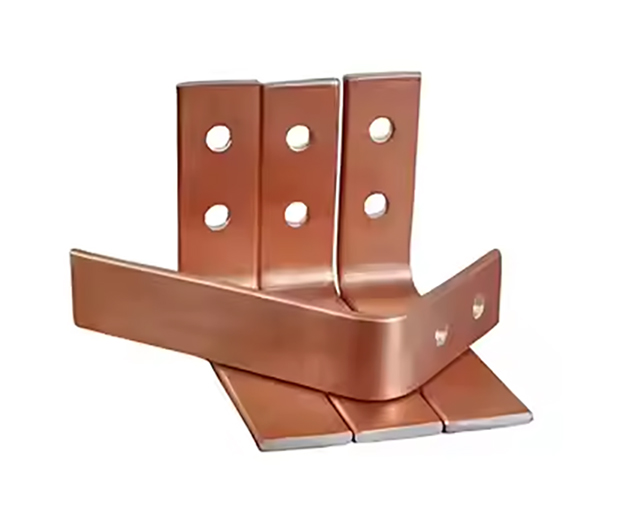

Pure Copper Busbars are manufactured from high-purity electrolytic copper with a minimum copper content of 99.99%, ensuring exceptional electrical conductivity and mechanical strength. These busbars are vital components in electrical power distribution, grounding systems, battery assemblies, and industrial machinery.
At G and N Fortune Limited, we provide a wide range of Pure Copper Busbar solutions including Flat Pure Copper Busbar, Solid Pure Copper Busbar, and fully Custom Pure Copper Busbar configurations. Our products meet stringent international standards and are designed to deliver excellent performance and long service life.

Made from premium-grade Electrolytic Tough Pitch (ETP) Copper (C11000), guaranteeing conductivity ≥101% IACS.
Superior corrosion resistance and thermal conductivity.
Available with bare copper finish or protective coatings like tin plating for enhanced durability.
Flat Pure Copper Busbar: Ideal for compact electrical panel layouts and power distribution boards.
Solid Pure Copper Busbar: Suitable for high-current, heavy-duty industrial environments requiring high mechanical strength.
Pure Copper Busbar Strip and Rod: For specialized electrical connections and customized installations.
Fully Custom Pure Copper Busbar options are available to fit specific hole patterns, lengths, and thicknesses.
Pure Copper Busbars are critical components in a wide array of electrical and industrial systems due to their superior conductivity, durability, and versatility. Below are some key application areas where they deliver outstanding performance:
In power distribution networks—whether in commercial buildings, industrial complexes, or utility substations—Pure Copper Busbars serve as the backbone for efficient current flow. Their high conductivity minimizes energy losses and heat generation, ensuring reliable distribution of electricity across circuits. Flat and solid busbars help maintain compact, organized panel designs while supporting high current loads.
Switchgear assemblies require robust, low-resistance conductors to handle switching operations and fault currents safely. Pure Copper Busbar for Switchgear provides the mechanical strength and electrical performance needed for both low-voltage and medium-voltage switchboards. Tin-plated or silver-plated options improve longevity by resisting oxidation in high-use environments.
Control panels for machinery and automation systems rely on Pure Copper Busbars for precise power delivery and grounding. The ability to customize busbar dimensions and hole patterns allows seamless integration into complex control cabinet layouts, enhancing both electrical safety and operational efficiency.
Effective grounding is vital for electrical safety, protecting equipment and personnel from electrical faults and surges. Pure Copper Grounding Busbar offers an optimal solution due to its excellent corrosion resistance and conductivity. It provides a stable path for fault currents and helps maintain system integrity in harsh environments.
In rapidly growing sectors such as electric vehicles (EVs), renewable energy, and large-scale battery energy storage systems (BESS), Pure Copper Busbars are essential for efficient current collection and distribution. They ensure minimal voltage drop and thermal build-up, critical for the safety and performance of battery packs and charging stations.
Heavy-duty industrial machinery demands durable and reliable power connections capable of withstanding mechanical vibrations and thermal stress. Solid Pure Copper Busbars are commonly used in motor control centers, transformers, and large industrial drives, delivering consistent performance under challenging operational conditions.
| Parameter | Specification |
|---|---|
| Material | Electrolytic Tough Pitch Copper (C11000) |
| Copper Purity | ≥99.99% |
| Conductivity | ≥101% IACS |
| Thickness Range | 1 mm – 50 mm |
| Width Range | 10 mm – 300 mm |
| Length | Customizable |
| Surface Finish | Bare copper, Tin-plated, Silver-plated |
| Shapes | Flat, Solid, Strip, Rod |
| Standards Compliance | IEC 60439, RoHS, UL (optional) |
When selecting a Pure Copper Busbar, consider the following:
Current Capacity: Determine cross-sectional area based on your electrical load requirements with safety margins.
Installation Environment: For corrosive or humid environments, tin plating or other protective finishes are recommended.
Mechanical Requirements: Solid busbars provide better resistance to vibration and mechanical stress.
Space Constraints: Flat busbars maximize space efficiency in panel assemblies.
Thermal Management: Copper’s excellent heat dissipation reduces temperature rise and prolongs component lifespan.
Our engineering team is ready to assist in optimizing your busbar design for maximum performance and durability.
Extensive expertise as a leading Pure Copper Busbar Manufacturer.
Comprehensive customization options tailored to your exact needs.
Advanced manufacturing facilities including CNC cutting, punching, and plating.
Rigorous quality control ensuring compliance with international standards.
Fast turnaround times and reliable global logistics.
Dedicated customer service and technical support.
Q1: What is the difference between pure copper busbars and copper alloy busbars?
A1: Pure copper busbars contain ≥99.99% copper, offering higher electrical conductivity and better corrosion resistance than copper alloy busbars, which include additional metals that may reduce conductivity.
Q2: Can I order custom sizes and shapes?
A2: Yes, we offer fully Custom Pure Copper Busbar fabrication including custom dimensions, hole patterns, and surface treatments.
Q3: What surface finishes are available?
A3: Options include bare copper, tin plating to prevent oxidation, and silver plating for enhanced conductivity.
Q4: How do I determine the correct busbar size?
A4: The size depends on current load, voltage, environmental conditions, and installation space. Our engineers can assist with precise sizing and design recommendations.
Q5: Do your busbars comply with international standards?
A5: Yes, our products meet IEC, RoHS, UL, and other industry standards ensuring safety and quality.